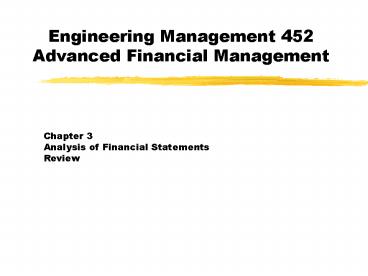Engineering Management 452 Advanced Financial Management PowerPoint PPT Presentation
1 / 17
Title: Engineering Management 452 Advanced Financial Management
1
Engineering Management 452 Advanced Financial
Management
Chapter 3 Analysis of Financial Statements Review
2
Analysis of Financial Statements
- Ratio analysis
- Du Pont system
- Effects of improving ratios
- Limitations of ratio analysis
- Qualitative factors
3
Ratio Analysis
- A ratio is simply one number divided by another.
Not all ratios are relevant for all industries.
Must understand what the ratio is telling us to
determine its usefulness. - What is the unit of measurement? What might a
high or low value be telling us? How can this
number be improved?
4
Why are ratios useful?
- Standardize numbers facilitate comparisons
- Used to highlight weaknesses and strengths
5
Five Major Categories of Ratios
- Liquidity Can we make required payments as they
fall due? - Asset management Do we have the right amount of
assets for the level of sales? - Debt management Do we have the right mix of
debt and equity? - Profitability Do sales prices exceed unit
costs, and are sales high enough as reflected in
PM, ROE, and ROA? - Market value Do investors like what they see as
reflected in P/E and M/B ratios?
6
Examples of Liquidity Ratios
- Current ratio Current assets / Current
liabilities - Quick ratio (Current assets Inventory) /
Current liabilities - Cash Ratio Cash / Current Liabilities
7
Examples of Asset Management Ratios
- Inventory Turnover Ratio Sales / Inventories
- Days Sales Outstanding Receivables / Average
Sales per day (also called Average Collection
Period - Fixed Asset Turnover ratio Sales / Net Fixed
Assets - Total Asset Turnover ratio Sales / Total Assets
8
Examples of Debt Management Ratios
- Debt ratio (Total Debt) / Total assets
- Times Interest Earned EBIT / Interest charges
- EBITDA Coverage Ratio (EBIT Lease Payments) /
(Interest charges Principal payments Lease
Payments
9
Examples of Profitability Ratios
- Profit margin Net Income available to CS /
Sales - Basic Earning Power EBIT / Total Assets
- Return on Assets Net Income available to CS /
Total Assets - Return on Common Equity Net Income available to
CS / Common Equity
10
Examples of Market Value Ratios
- Price Earnings Ratio Price per Share / Earnings
per share - Price to Cash Flow Ratio Price per share / Cash
Flow per share - Market to Book Ratio Market value per share /
Book value per share - Book value per share is common equity divided by
the number of shares outstanding
11
Trend Analysis
- Trend analysis simply plots a trend over time
- Common Size Analysis
- All income items are divided by sales and all
balance sheet items are divided by total assets - Percentage Change Analysis
- Growth rates are calculated for all income
statement items and balance sheet accounts
12
Du Pont System
Focuses on
- Expense control (PM)
- Asset utilization (TATO)
- Debt utilization (EM)
It shows how these factors combine to determine
the ROE.
13
Du Pont Equation
- ROA Profit Margin x Total Asset Turnover ROE
Profit Margin x Total Asset Turnover x Equity
Multiplier
14
Potential problems and limitations of financial
ratio analysis
- Comparison with industry averages is difficult if
the firm operates many different divisions. - Average performance is not necessarily good.
- Seasonal factors can distort ratios.
(More)
15
Potential problems and limitations of financial
ratio analysis
- Window dressing techniques can make statements
and ratios look better. - Different accounting and operating practices can
distort comparisons. - Sometimes it is difficult to tell if a ratio
value is good or bad. - Often, different ratios give different signals,
so it is difficult to tell, on balance, whether a
company is in a strong or weak financial
condition.
16
Qualitative factors
- Are the companys revenues tied to a single
customer? - To what extent are the companys revenues tied to
a single product? - To what extent does the company rely on a single
supplier?
(More)
17
Qualitative factors
- What percentage of the companys business is
generated overseas? - What is the competitive situation?
- What does the future have in store?
- What is the companys legal and regulatory
environment? - And so on.

